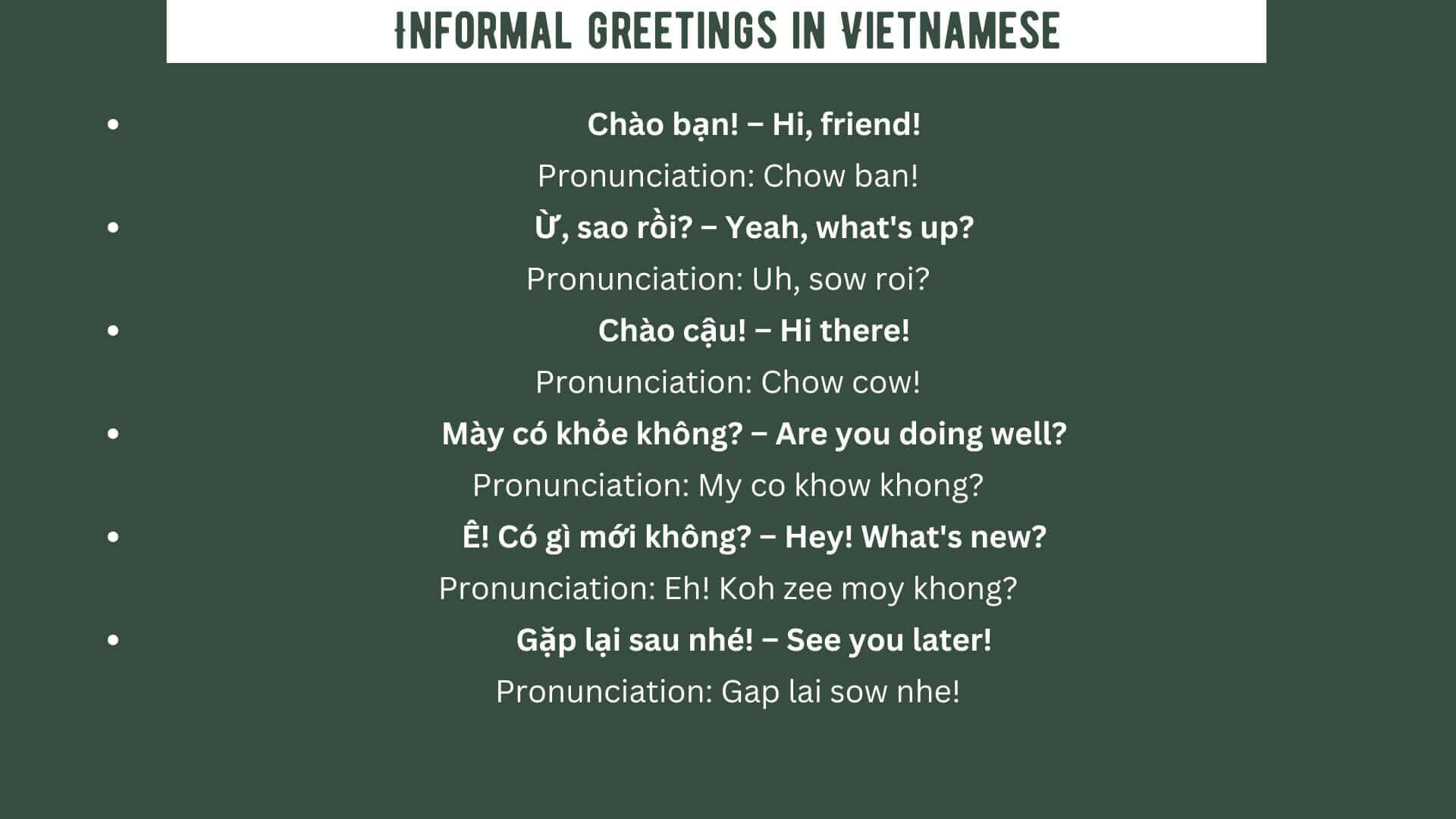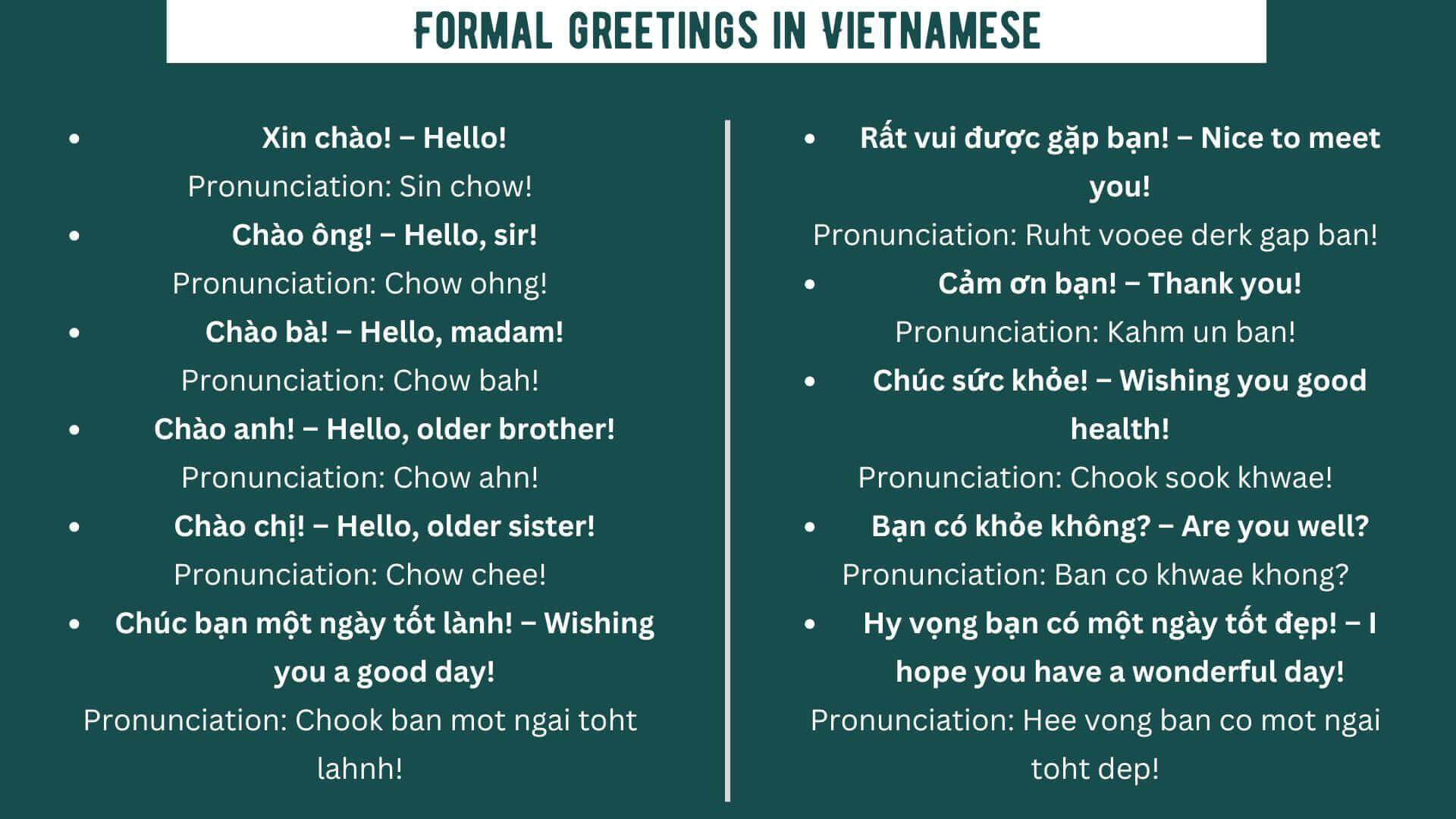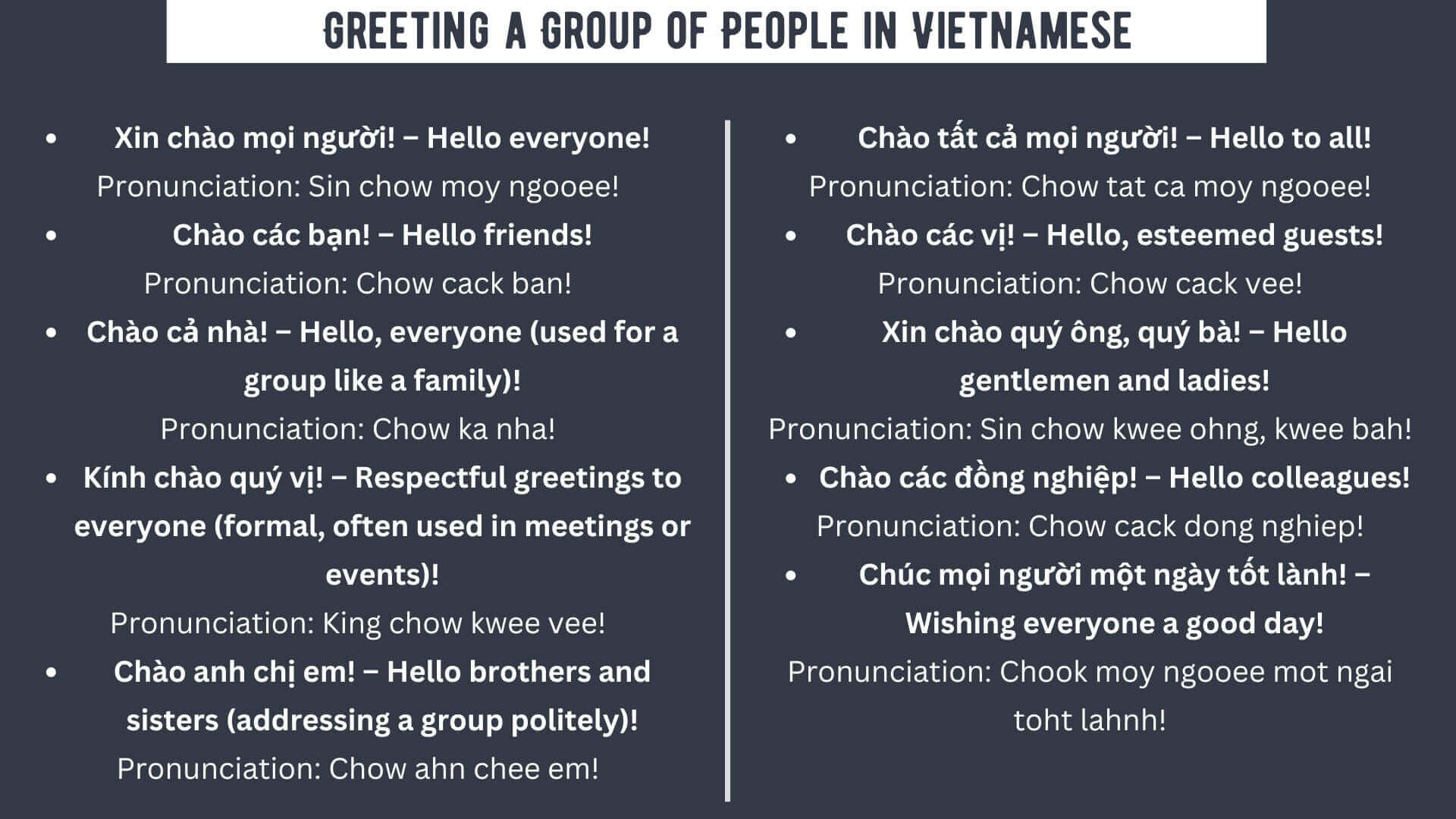Vietnamese culture is rich and deep, and the way you greet someone really matters. While ‘Xin chào’ is a basic hello known by everyone, there are many other ways to say it, from casual ‘Chào bạn’ to the more formal ‘Xin kính chào.’ Knowing over 35 different greetings isn’t just about speaking the language better; it’s about connecting with people on a deeper level. Each greeting tells us something about respect and how people see each other. It’s fascinating to see how simple words can show us a lot about what people value and how they relate to each other.
The Basic Hello in Vietnamese
Xin chào
When starting a conversation in Vietnamese, you often use the greeting ‘Xin chào.’ It’s a common and polite way to say hello, no matter where you are or who you’re talking to. You pronounce it as ‘sin chow.’ You can use this greeting anytime, whether you’re speaking face-to-face or on the phone. It’s a key part of basic Vietnamese communication. Using ‘Xin chào’ shows respect and understanding of the culture. It’s a good way to start a conversation on the right foot, showing you’re interested in polite and friendly communication.
Informal Greetings
Informal greetings in Vietnamese usually start with ‘Chào bạn,’ meaning ‘Hello, friend.’ It’s common among friends and people who know each other well. This simple greeting helps everyone feel at ease. Young people often just say ‘Chào’ and add the person’s nickname or first name. For example, ‘Chào Mạnh’ is a casual way to say hello to someone named Mạnh. After the greeting, it’s typical to ask, ‘khỏe không?’ or ‘how are you?’ A common response is ‘Khoẻ, cảm ơn,’ which means ‘I’m fine, thank you.’ These phrases are key in daily conversations and show the friendly, communal spirit of Vietnam.

- Chào bạn! – Hi, friend!
Pronunciation: Chow ban! - Ừ, sao rồi? – Yeah, what’s up?
Pronunciation: Uh, sow roi? - Chào cậu! – Hi there!
Pronunciation: Chow cow! - Mày có khỏe không? – Are you doing well?
Pronunciation: My co khow khong? - Ê! Có gì mới không? – Hey! What’s new?
Pronunciation: Eh! Koh zee moy khong? - Gặp lại sau nhé! – See you later!
Pronunciation: Gap lai sow nhe!
Formal Vietnamese Greetings
In Vietnamese culture, formal greetings are very important. They show respect and recognize someone’s social status. When you meet someone in a formal setting, you usually say ‘Xin chào,’ followed by a title like ‘ông’ for an older man, or ‘bà’ for an older woman. This is similar to saying ‘Hello, sir’ or ‘Hello, ma’am’ in English. These greetings are polite and show you respect the person’s age and position. There’s also a very formal greeting, ‘Xin kính chào,’ used in special situations like formal letters or speeches. It shows even greater respect.

- Xin chào! – Hello!
Pronunciation: Sin chow! - Chào ông! – Hello, sir!
Pronunciation: Chow ohng! - Chào bà! – Hello, madam!
Pronunciation: Chow bah! - Chào anh! – Hello, older brother!
Pronunciation: Chow ahn! - Chào chị! – Hello, older sister!
Pronunciation: Chow chee! - Chúc bạn một ngày tốt lành! – Wishing you a good day!
Pronunciation: Chook ban mot ngai toht lahnh! - Rất vui được gặp bạn! – Nice to meet you!
Pronunciation: Ruht vooee derk gap ban! - Cảm ơn bạn! – Thank you!
Pronunciation: Kahm un ban! - Chúc sức khỏe! – Wishing you good health!
Pronunciation: Chook sook khwae! - Bạn có khỏe không? – Are you well?
Pronunciation: Ban co khwae khong? - Hy vọng bạn có một ngày tốt đẹp! – I hope you have a wonderful day!
Pronunciation: Hee vong ban co mot ngai toht dep!
Greeting a Group of People
When you greet a group in Vietnamese, it’s common to say ‘Xin chào các bạn,’ which means ‘Hello everyone.’ This is a friendly way to say hi in casual settings, no matter who is in the group. It makes everyone feel welcome, especially at social events or informal meetings. For a more formal group or when different ages are present, you might want to change it to ‘Xin chào quý vị.’ This is more respectful and fits better in professional situations. It keeps the greeting polite, as expected in Vietnamese culture, making sure everyone feels respected.

- Xin chào mọi người! – Hello everyone!
Pronunciation: Sin chow moy ngooee! - Chào các bạn! – Hello friends!
Pronunciation: Chow cack ban! - Chào cả nhà! – Hello, everyone (used for a group like a family)!
Pronunciation: Chow ka nha! - Kính chào quý vị! – Respectful greetings to everyone (formal, often used in meetings or events)!
Pronunciation: King chow kwee vee! - Chào anh chị em! – Hello brothers and sisters (addressing a group politely)!
Pronunciation: Chow ahn chee em! - Chào tất cả mọi người! – Hello to all!
Pronunciation: Chow tat ca moy ngooee! - Chào các vị! – Hello, esteemed guests!
Pronunciation: Chow cack vee! - Xin chào quý ông, quý bà! – Hello gentlemen and ladies!
Pronunciation: Sin chow kwee ohng, kwee bah! - Chào các đồng nghiệp! – Hello colleagues!
Pronunciation: Chow cack dong nghiep! - Chúc mọi người một ngày tốt lành! – Wishing everyone a good day!
Pronunciation: Chook moy ngooee mot ngai toht lahnh!
Greetings Based on the Time of Day
Understanding greetings based on the time of day is key to polite communication in Vietnamese culture. The language has specific phrases for different times. For instance, from about 6 am to 10 am, you say ‘chào buổi sáng,’ which means ‘good morning.’
Later, from noon to the late afternoon, you switch to ‘chào buổi chiều,’ or ‘good afternoon.’ And from sunset onwards, it’s ‘chào buổi tối’ for ‘good evening.’ Using these time-specific greetings shows you know both the language and the culture. It’s a big part of daily life in Vietnam.
- Chào buổi sáng! – Good morning!
Pronunciation: Chow boo-ee sahng! - Chào anh/chị! – Good afternoon! (formal)
Pronunciation: Chow ahn/chee! - Chào buổi chiều! – Good afternoon!
Pronunciation: Chow boo-ee chee-ow! - Chào buổi tối! – Good evening!
Pronunciation: Chow boo-ee toy! - Chúc ngủ ngon! – Good night!
Pronunciation: Chook ngoong ngon! - Chào cả ngày! – Hello all day! (used casually)
Pronunciation: Chow ka ngai! - Chào mừng buổi sáng! – Welcome to the morning!
Pronunciation: Chow mung boo-ee sahng! - Chào bạn, bữa trưa vui vẻ! – Hello, enjoy your lunch!
Pronunciation: Chow ban, boo-ah troo-ah vooee veh! - Chúc các bạn một buổi tối vui vẻ! – Wishing you all a pleasant evening!
Pronunciation: Chook cack ban mot boo-ee toy vooee veh! - Chúc bạn có một ngày tuyệt vời! – Wishing you a wonderful day!
Pronunciation: Chook ban co mot ngai twee-it voi!
Conclusion
In short, the variety of greetings in Vietnamese shows how much the culture values respect and proper behavior in talking with others. Knowing these greetings helps people communicate better and show respect to everyone, no matter their age or social status. When you use the right greeting for each situation, from casual to formal, it shows that you really understand and honor Vietnamese culture. This leads to more meaningful and respectful conversations every day. Keep visiting the Translation Blog for more translations and master any language easily.

